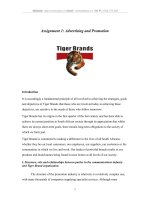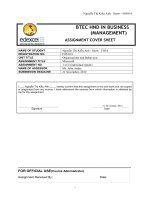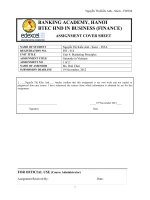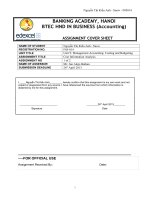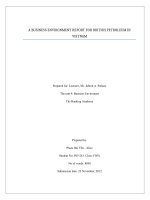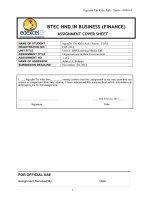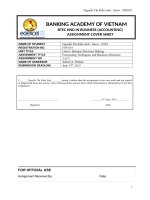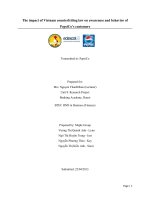Research Project Assignment 1
Bạn đang xem bản rút gọn của tài liệu. Xem và tải ngay bản đầy đủ của tài liệu tại đây (790.44 KB, 39 trang )
The impact of Vietnam counterfeiting law on awareness and behavior of
PepsiCo’s customers
Transmitted to: PepsiCo
Prepared for:
Mrs. Nguyen ThanhNhan (Lecturer)
Unit 8: Research Project
Banking Academy, Hanoi
BTEC HND in Business (Finance)
Prepared by: Maple Group
Vương Thị Quỳnh Anh - Lynn
Ngô Thị Huyền Trang - Jess
Nguyễn Phương Thảo - Key
Nguyễn Thị Kiều Anh - Snow
Submitted: 22/04/2013
Page | 1
TABLE OF CONTENTS
Page | 2
EXECUTIVE SUMMARY
Nowadays, counterfeit products become more and more development in the Vietnam market.
The negative consequences that it brings to society are not small. It effects on consumer finance,
undermine the confidence of consumers about the transparency of commodity markets, and
detract reputation of the genuine manufacturer. As a result, counterfeiting law of Vietnam’s
government is a tool to protect the benefits of company and customers. In addition, it will reduce
the effects of counterfeit products with the development and reputation of company in
customers’ perception.
The research title is: “The impact of Vietnam counterfeiting law on awareness and behavior
of PepsiCo’s customers”
PepsiCo is a famous brand, it leads in convenient snacks, foods and beverages with revenues of
more than 60$ billion and over 285,000 employees from over 200 countries in over the world.
Especially, all of PepsiCo products are very easy to counterfeit. This research with the aims of
investigates the Viet Nam counterfeiting law in situation of PepsiCo, and it based on PepsiCo’s
customer. The research includes 3 chapters which are introduction, literature review, and
research methodology.
•
Chapter 1: Introduction, the report gives the information of NTC including history,
operation, and structure. Besides, there are some problem statements, following by
research objectives, research questions, action plan and target dates, research limitation,
and research ethics.
•
Chapter 2: Literature review includes all the definition or phrases related to the research.
•
Chapter 3: Research methodology includes research design, research sampling, research
instrument, and methods of data analysis.
Page | 3
CHAPTER 1
INTRODUCTION
1.1 Research Background.
Currently, counterfeiting, piracy, poor quality goods is one of the big problem of the society.
The negative consequences that it brings to society are not small. It effects on consumer
finance, undermine the confidence of consumers about the transparency of commodity
markets, and detract reputation of the genuine manufacturer.
Therefore, in order to know how is the state of counterfeiting, piracy, the current poor quality
in Vietnam? And the causes of counterfeiting, counterfeit, inferior quality product exist and
develop? What ways are needed to curb counterfeiting, counterfeit, inferior quality? This is
the main reason why our group chose research" The impact of Vietnam counterfeiting law
on awareness and behavior of PepsiCo’s customers" to discuss in the research.
1.1.1 History of the company
PepsiCo, Inc. is an America multinational company headquartered in Purchase, New York,
United States. Currently, it leads in convenient snacks, foods and beverages with revenues of
more than 60$ billion and over 285,000 employees from over 200 countries in over the
world. PepsiCo consists of PepsiCo Americas Foods (PAF), PepsiCo Americas Beverages
(PAB) and PepsiCo International (PI). According to detail information which is posted in
PepsiCo’s website, the company experiences more than 47 years with many development
stages. Below is some main point in the history of PepsiCo:
•
1965 - PepsiCo was formed by Donald M. Kendall, President and Chief Executive
Officer of Pepsi-Cola and Herman W. Lay, Chairman and Chief Executive Officer of
Frito-Lay, through the merger of the two companies.
•
1970 - PepsiCo moves from New York City to new world headquarters in Purchase,
N.Y. PepsiCo is the first company to respond to customer preference with
lightweight, recyclable, plastic bottles.
•
1974 - PepsiCo becomes the first American consumer product to be produced,
marketed and sold in the former Soviet Union.
Page | 4
•
1980 - PepsiCo Food Service International (PFSI) is formed to focus on overseas
development of restaurants.
•
1982 - Pepsi Free and Diet Pepsi Free, the first major brand caffeine-free colas, are
introduced. Inauguration of the first Pepsi-Cola operation in China
•
1985 - PepsiCo is now the largest company in the beverage industry. The company
has revenues of more than $7.5 billion, more than 137,000 employees. Pepsi-Cola
products are available in nearly 150 countries and territories around the world. Snack
food operations are in 10 international markets.
•
1986 - PepsiCo purchases 7Up international, the third largest franchise soft drink
operation outside the United States
•
1993 - Pepsi- Cola introduces Aquafina bottled water into test market.
•
1996 - Pepsi-Cola launches Pepsi World at www.pepsiworld.com (PepsiCo, n.d.)
1.1.2 Mission and Vision
At PepsiCo, they believe being a responsible corporate citizen is not only the right thing
to do, but the right thing to do for their business.
•
Mission
PepsiCo’s mission is “to be the world’s premier consumer Products Company focused on
convenient foods and beverages. PepsiCo try to produce financial rewards to investors as we
provide opportunities for growth and enrichment to our employees, our business partners
and the communities in which we operate. And in everything we do, we strive for honestly,
fairness and integrity” (PepsiCo, n.d.)
By always create the belief and trust for stakeholder, also always set themselves ethics in
business, PepsiCo deserve getting more succeed in the future.
•
Vision
Besides, PepsiCo also set a specific vision which is “PepsiCo’s responsibility is to
continually improve all aspects of the world in which we operate- environment, social,
economic social, economic- creating a better tomorrow than today” (PepsiCo, n.d.)
Page | 5
It can be said that vision of PepsiCo is very precious because they understand the role of
customer in business. They focus more on customers and environment around customers.
This proves that PepsiCo only interested in economic development - immediate benefit, that
they ignored the long-term benefits of environmental protection and health of customer as
well. This makes increase the belief of customer with company. Therefore, since established,
the strategic vision of PepsiCo makes the company develop significantly and in a short time,
it becomes market leader of Fast-Moving Consumer Goods (FMCG) industry.
1.1.3 Value and Philosophy
Values & Philosophy are the foundation for business decision of PepsiCo.
PepsiCo’s values are sustained growth, empowered people, responsibility and trust “They are
committed to delivering sustained growth through empowered people acting responsibly and
building trust”
The company maintains their values by 6 philosophies:
- Care for our customers, our consumers and the world we live in
- Sell only products we can be proud of
- Speak with truth and candor
- Balance short term and long term
- Win with diversity and inclusion
- Respect others and succeed together (PepsiCo, n.d.)
1.1.4 Organizational structure
Chart 1: PepsiCo’s organizational Chart (Source: PepsiCo.com)
Page | 6
For PepsiCo’s robust growth in recent years, PepsiCo felt it was time to manage the company
as three units instead of two to sustain our growth rate and also to develop global senior
leadership talent for PepsiCo’s future. Therefore, PepsiCo created three operating business
units: PepsiCo Americas Foods (PAF), PepsiCo Americas Beverages (PAB), and PepsiCo
International (PI). They believed that this organizational structure will help them deliver
strong top-line performance and profit growth (PepsiCo, n.d.)
1.1.5 PepsiCo’s Products
Products
Pepsi, Twister, Sting
Beverages
Lipton Ice Tea,
Aquafina, Gatorade
Snack Poca, PocNutz,
Snack PocaSelectz
Foods
Snack Cheetos, Lays
Chip, Flat Earth Snack
Table 1: PepsiCo’s Product
Page | 7
1.1.6 Overview of the PepsiCo’s operation in Vietnam
•
4/12/1991 - International Beverage Company (IBC) was established as a joint venture
between SP.Co and Marcondray-Singapore with capital contribution of 50% - 50%
•
2/ 1994 - The US Embargo to Vietnam was lifted marking the phenomenal entrance
of PepsiCo into new market. The diverse product portfolios including PepsiCola,
7Up, Mirinda, Aquafina, Sting, Twister, and Lipton Ice Tea are widely and deeply
distributed to Vietnamese consumers from the five operations branches located across
Vietnam.
- Officially, PepsiCo teamed up with International Beverages Company (IBC) – a
well-established local joint venture to manufacture and distribute Pepsi-Cola and 7Up
products in Vietnam
- PepsiCo held 30% equity of the joint venture (JV) with the other two partners –
SP.Co (Vietnamese) and Macondray (Singapore) sharing the balance.
•
1998 - PI bought 97% stocks, SPCo 3%, up to $110 million invested.
•
2003 - PepsiCola Global Investment bought the remaining 3%, renamed the company
into the International Beverage Company PepsiCo Vietnam.
•
2005 - Officially became the company which has largest market share in Vietnam
•
2006 - Launch of the first food product (Snack Poca)
•
2007 - Development of new sector - Soy Milk
•
2008 - Inauguration of factory packaged foods in Binh Duong (PepsiCo, n.d.).
1.2 Problem Statement
Research title is about: “The impact of Vietnam counterfeiting law on awareness and
behavior of PepsiCo’s customers”
There are many problems in Vietnam counterfeiting law and applying Vietnam
counterfeiting law that cause impact on customers of PepsiCo. With each problem, PepsiCo
also has to face specific influences.
Page | 8
Problem 1: The difficulties in product quality inspection in Vietnam (Quality
inspection factor)
Director of market manager department of Hanoi said that the identification of counterfeit
and poor quality goods on the market is not difficult, but in order to prove it is counterfeit
products before handling is not easy.
According to Decree No.140-HĐBT (25/4/1991) assign about inspection, handling the
production, trafficking in counterfeit goods and Decree No.115-HĐBT (13/4/1991) provides
for the implementation of the Ordinance Measurement, it wrote:
- The handling of counterfeit and poor quality products required assessment concluded
counterfeiting
- The applicant must pay the amount of violation assessment (moi.gov.vn, n.d.)
The fact is that the costs of inspection for counterfeit and poor quality products are very
expensive. Assessment agency must pay inspection fee in advance. After inspection, if it is
counterfeit goods, they will destroy it immediately and the violators will have to pay
penalty, but hardly do violators pay it. This is difficult for assessment agency to complete
their responsibility. Thus, it leads to many kinds of products which does not ensure about
quality still exist in market blatantly. Therefore, these problem effects directly on PepsiCo’s
operation and especially they make reduce the belief of customers to company’s products.
Problem 2: There are many gaps in Vietnam counterfeiting law (Regulation factor)
Currently, Vietnam government is fighting against counterfeit goods by applying laws
strictly. However, Vietnam counterfeiting law still exist gaps leading to the appearance of
new criminal behavior. According to article 320 of Law of Trade “Since 2001 - 2011,
relevant agencies have conducted tests and discovered handled 2017 cases of administrative
violations, of which, poor quality service is 1752, counterfeiting and violations of
intellectual property rights, industrial designs of 265 cases” (moi.gov.vn, n.d.).
According to Do Van Phuoc, the Director of Market Management Department, and Deputy
Minister Steering Committee 127/TG, the difficulties that the industry is facing in fighting
against counterfeit goods and trade fraud is:
Page | 9
- The regulations in term of counterfeit goods are unclear, for instance in many cases,
quality goods are very poor, but lack of basic legal to conclude that that is fake products
- The legal documents also lack of unity.
- There are not any methods strong enough or suitable for fighting against counterfeit and
poor quality products (dantri.com, n.d.)
This problem is very serious and it effects significantly on legal benefits of customers and
PepsiCo as well.
Problem 3: Citizens do not have high awareness in fighting against counterfeit
products (Customer awareness factor)
In some transactions, when customer purchases and uses goods, they hardly interested in
providing sufficient information to ensure legal benefits after buying goods. At the same
time disregard the reference manual goods manufacturers, which led to the dispute with
company when they buy fake and poor quality products.
Moreover, almost Vietnam consumers do not concern more about detecting fake goods. In
contract, they only interested in product’s beauty (whether it are beautiful or not) and
product’s price (whether it cheap or not). However, in fact fakes products always more
beautiful, and especially their prices is cheaper than original products so consumers always
are attracted by counterfeit and poor quality products. Customers do not assess serious
impact of their counterfeit product to their health so they do not have high awareness in
fighting against counterfeit product. This also is a big problem make difficulties in applying
Vietnam counterfeiting law.
Problem 4: Vietnam government and company is lack of propaganda program to help
customer distinguish between original and counterfeit products (Activity factor)
Nowadays, counterfeiting and piracy is the risk of the economy in Viet Nam; many activity
counterfeiting, piracy is going on around the world with various large and small scale. The
product counterfeiting, piracy increasingly in many forms such as: copy brand, style or false
geographical indication. One of the most reasons is because consumer cannot distinguish
between original and counterfeit products. PepsiCo produce snack, foods, and beverages; all
Page | 10
of them are products which easy to counterfeited. The counterfeiter used the old packaging
to make new fake products with the same brand but the water inside is bad quality,
inexpensive material; therefore, the health of customer can be harm. In this case, the
consumers have difficulty to identify. In Viet Nam, the government and company do not
have implemented the program to guide consumer distinguish between original and
counterfeit goods, leading to the weakness of the company in helping customers choose the
real products with good quality.
Problem 5: Consumer using counterfeiting product because of low living standard
(Living standard factor)
With the development of economy, the living standard is improved but when compare with
country in Asia, the living standard of Vietnamese people is very low. According to figures
of the Ministry of Industry and Trade, in 2011 GDP estimated at U.S. $ 119 billion. Capita
GDP reached $ 1,300 / person / year Invalid source specified.. This number is low when
compare with other country such as Chinese about $6,786 / person / yearInvalid source
specified.. Because of low standard living, people in Vietnam choose using fake products
that is cheap and suitable with their financial situation instead of original product. As a
result, if government want to reduce counterfeit goods in market, one of the most important
things that government have to do is improve living standard especially income of
Vietnamese people. It can protect company and customer from effect of fake product. In
addition, it can bring more revenue for company and protect customer especially health of
customers from low quality product in the market.
1.3 Research Objective
In competitive business environment, Vietnam government has many ways to protect
benefits of companies and customers. One of them is counterfeiting law. For the research
topic: “The impacts of Vietnam counterfeiting law on awareness and behavior of PepsiCo’s
customers”, this research aims to achieve the following objectives:
•
To understand the advantages and the disadvantages of Vietnam’s counterfeiting law
which influence on employees and customers of PepsiCo
Page | 11
•
To find out the main reason that Vietnam government cannot prevent development
of counterfeit and poor products
•
To help PepsiCo have more information about regulations and new terms of the
counterfeiting law of Vietnam
•
To understand deeply ways that counterfeit product spread into market to prevent its
development
•
To know ways PepsiCo fight against counterfeit to reduce its effects on the
development of PepsiCo and customers’ health as well
•
To raise awareness of customers in distinguish fake and poor quality product
•
To help customers know their rights, and their benefits and give solutions for them
when buying counterfeit and poor product
With the clear objective, this research can help PepsiCo understanding about the benefits
and limitations of Vietnam counterfeiting law with company. Moreover, this research can
give some solution that company solve with anti- counterfeiting from that PepsiCo can give
best project to reduce the effects of counterfeiting product to revenue and reputation of
PepsiCo in Vietnam. In addition, customers can have knowledge and some solution to solve
when they met fake product in market so customers can choose original product that good
for their health.
1.4 Significant of study
Research topic is “The impacts of Vietnam counterfeiting law on awareness and
behavior of PepsiCo’s customers”. As a result, this research will provide useful information
for specific group of people.
First, for company (PepsiCo), this research will help them understand more about
counterfeiting situation in Viet Nam. Then, it will be much easier for PepsiCo to find out the
solutions and they can feel comfortable to cooperate with the government to prevent
counterfeiting.
Second, for managers and employees, this research gives more knowledge about
regulations of Vietnam counterfeiting law so that managers and employees recognize the
important role of counterfeiting law. From this awareness, managers and employees can give
new ideas, give the best ways to fighting against counterfeit and poor products, and improve
Page | 12
the shortcomings in protecting their brand to remain the development of company and
PepsiCo’s leader position.
Third, for customers, the research help customers raise awareness in distinguish counterfeit
and poor product to ensure legal benefits and give some ways to deal with problems when
buying counterfeit and poor product.
Fourth, for students, this research helps student know how Vietnam counterfeiting law
impact on customers of specific company. Moreover, students have more experiences to do
research especially research about the Vietnam counterfeiting law and have more
understanding about the business environment in Vietnam.
Finally, for future researchers, by using our information and data, comparing with our
strong point and weakness; they can improve their research successfully.
1.5. Research Questions/ Hypotheses
1.5.1 Research Questions
The survey is the most useful method to help our group gather more information and
understand deeply Vietnam counterfeiting law. List of questionnaires are designed based on
factors existing in the fact and are modified to suit with the aim of the research and achieve
the best results.
The research question for this study will be:
1. What is the respondents’ profile in terms of?
1.1 Gender
1.2 Age
1.3 Occupation
1.4 Education level
1.5 Civil status
2. What is the significant relationship between the respondents’ profile and their awareness
of PepsiCo’s customers about Vietnam counterfeiting law?
3. What are the problems in applying counterfeiting law in Vietnam?
3.1 Quality inspection
3.2 Regulation
3.3 Customer awareness
Page | 13
3.4 Activity
3.4 Living standard
4. What is the significant relationship between problems in applying Vietnam counterfeiting
law and behavior of customers of PepsiCo?
1.5.2 Hypothesis
There are 10 hypotheses for this research based on the conceptual frameworks below:
What is the respondents’
profile in terms of?
Awareness of PepsiCo’s customers
1. Gender
2. Age
3. Occupation
4. Education level
5. Civil status
about Vietnam counterfeiting law
5. Employment status
INDEPENDENT VARIABLES
DEPENDENT VARIABLES
Figure 1: Conceptual framework 1
1. Is there a significant relationship between gender of respondents and their awareness
PepsiCo’s customers about Vietnam counterfeiting law?
2. Is there a significant relationship between age of respondents and their awareness of
PepsiCo’s customers about Vietnam counterfeiting law?
3. Is there a significant relationship between occupation of respondents and their
awareness of PepsiCo’s customers about Vietnam counterfeiting law?
4. Is there a significant relationship between education level of respondents and their
awareness of PepsiCo’s customers about Vietnam counterfeiting law?
5. Is there a significant relationship between civil status of respondents and their
awareness of PepsiCo’s customers about Vietnam counterfeiting law?
Factors
1. Quality inspection
2. Regulation
3. Customer awareness
4. Activity
5. Living standard
Page | 14
Behavior of PepsiCo’s customers
INDEPENDENT VARIABLES
DEPENDENT VARIABLES
Figure 2: Conceptual framework 2
6. Is there a significant relationship between quality inspection factor and behavior of
PepsiCo’s customers?
7. Is there a significant relationship between regulation factor and behavior of PepsiCo’s
customers?
8. Is there a significant relationship between customer awareness factor and behavior of
PepsiCo’s customers?
9. Is there a significant relationship between activity factor and behavior of PepsiCo’s
customers?
10. Is there a significant relationship between living standard factor and behavior of
PepsiCo’s customers?
From these hypotheses, our group makes 20 questionnaires by using main methodologies
(Mono-method and Multiple-method choice) to collect and gather information from 100
respondents who are customers of PepsiCo and live in Hanoi. The most important purpose
of questionnaires is to take opinions and feedbacks of customers. However, besides
advantages, making the survey also has some disadvantage, for instance lack of depth and
detail, significance of data can be neglected, responses may be inaccurate or not fully
honest.
1.6 Action Plan and Target Date
1
Activities
Creating a group (Maple Group)
Due dates
01/03/2013
Members
Lynn (leader),
Page | 15
Snow, Jess,
Together reading the scenario for understanding
2
Reading scenario and understanding deeply tasks in assignment
3
1
Looking for a company which is within the limits of the scenario
4
(Choose PepsiCo)
At home, all members had to:
02/03/2013
All members
06/03/2013
All members
07- 09/03/2013
All members
10/03/2013
All members
11/03/2013
All members
14/03/2013
16/03/2013
18/03/2013
All members
All members
Lynn
Preparing approval letter
19/03/2013
Snow
Meeting PepsiCo’s manager for a permission
21/03/2013
All members
- Think and choose aresearch title for PepsiCo
- Find any documents from books and Internet which related to
5
6
7
8
9
1
0
1
1
1
2
1
3
1
the research title
Holding 1st meeting for making 3 titles
Present research title before class and asking lecturer for a title
acceptance
The second submit titles and choose 1 research title for PepsiCo
Holding 2ndmeeting to make problem statements
Checking problem statements with lecturer
At home, each member prepared a suitable questionnaire for the
All members
24/03/2013
Holding 3rd meeting for conducting the questionnaire
25/03/2013
All members
Asking lecturer for checking the questionnaire
28/03/2013
Jess
Doing chapter 1:
5
- Leader divided works for each member with a deadline.
- Members went home and did their own tasks.
6
22 -
next meeting
4
1
1
Key
29 31/03/2013
All members
- Members submitted their work to leader to complete chapter 1
- Submitted total chapter 1 for lecturer to give feedbacks
- Checking and fixing together chapter 1
01 03/04/2013
All members
- Dividing new tasks of chapter 2 for all members
Page | 16
1
7
Doing chapter 2:
- Dividing work and doing research about chapter 2
1
All members submitted their work to leader to conduct a
8
completed chapter 2
04-07/04/2013
All members
08/04/2013
Key
Submit to lecturer to receive feedbacks
1
9
- Checking together chapter 2 and fixing if there was any
problems
- Making a plan for giving questionnaires to respondents
09 10/04/2013
All members
- Summarising the results of doing questionnaire
2
0
2
1
2
2
2
3
2
4
2
5
Doing chapter 3:
Discuss the tasks for chapter 3 and divide work
Doing assigned tasks in chapter 3 at home
Asking lecturer for checking chapter 3
Fixing chapter 3
11/04/2013
12 14/04/2013
15/04/2013
16 -
- Conducting a completed report including introduction,
17/04/2013
18 -
conclusion, reference list, etc.
21/04/2013
Submitting Assignment 1
22/04/2013
All members
All members
All members
All members
All members
All members
Page | 17
Chart 2: The Gantt chart for action plan of Maple Group
Chart 3: The Gantt chart for action plan of Maple Group
1.7 Research limitations
Our paper carries out a research into the impact of counterfeiting law on employees and
customers of PepsiCo.
To complete the research, we had a survey from one hundred
Page | 18
customers which include 100 customers at BigC supermarket, Vincom shopping mall,
Indochina Plaza, National Economic University, and Banking Academy.
Our paper also has some limitation below:
•
Limitation of company support: In order to conduct the survey, we need the
manager of PepsiCo to sign a letter approval first. However, PepsiCo is big company,
•
so it is hard to contact and ask permission from the manager as well.
Time constraint: Collecting and analyzing of data need a long time for the good
result while we only have one month to complete the research, therefore, the paper
•
cannot avoid some mistakes.
Limitation of respondents quantity: The result may be not objectiveness and
accuracy because the number of respondents is too small (100) while the number of
•
consumers of PepsiCo products is very wide.
Limitation of respondents support: When conducting survey employees of
•
PepsiCo, many people do not agree to answer our question.
Limitation of words: Research is about counterfeiting law and we have difficulty
•
when want to analyze deeply in each case of law because of the limitation of words.
Limitation of sources: We also have difficulty when the collecting information on
the Internet and others sources because counterfeiting law is not popular in Vietnam;
the State and PepsiCo also public much information about it.
1.8 Research ethics
Research ethics is a set of rules, regulations, implementation which researcher need to
comply; it describes the behavior and responsibility of researcher with their research objects.
The objective of research ethics is prescribe what researcher can or cannot to do research,
determine the power and responsibilities of researcher before doing research. It also protects
the safety and benefit of research objects to avoid abuse. To implement the study, we have to
follow some ethical below:
•
First, we respect the dignity, value and benefit of participant; all participants in this
research are volunteers, we do not force anyone to do survey and we protect
•
confidential communications.
We try to make them feel comfortable in helping us and when we complete results of
•
survey, we present all information related our survey honestly and objectivity.
Moreover, we informed fully about the purpose, methods and intended possible uses
of the research to participants.
Page | 19
•
Besides, we commit that all information, data, results, methods and procedures in the
•
research is true and reliable.
Especially, our research is about counterfeiting law, therefore we have to obey
relevant laws and institutional and governmental policies.
An informed consent form can be shown to participants. Here is an informed consent form
that group Maple used in research:
INFORMED CONSENT
Research title: “The impact of Vietnam counterfeiting law on employees and customers
of PepsiCo”
This survey is a requirement of Research Project, one unit for HND, in ITP, Banking
Academy.
Your participation is voluntary and we will not pay for your participation.
Your personal information will be kept secret.
If you want to contact us:
Please call (+84) 1699663898 to meet Lynn
Or sending us an e-mail:
1.9 Layout of chapter
The study consists of the following 5 chapters
•
•
•
•
•
Introduction
Literature review
Methodology
Result and discussion
Conclusion and recommendation
Page | 20
CHAPTER 2
LITERATER REVIEW
2.1 Introduction
2.1.1 Area
The key area of our research is “law”, it is very important not only for company, but
also the whole society. First of all, all people in the world need the law to ensure
fairness in society. According to Oxford Dictionary, ‘law is the system of rules which a
particular country or community recognizes as regulating the actions of its members
and which it may enforce by the imposition of penalties. Law has an important role for
the economic, social, political, and ethical ideas. For economic, legal create the
regulatory framework and a legal environment to ensure that all the economic can
active influence. For social, legal recognize and institute about the freedom and
interests of citizens. Legal is a tools help state and citizens protect their rights and
interests.
2.1.2 Topic
The topic of our research is “Vietnam’s counterfeiting law”. Counterfeiting, nowadays
appear in every field and category of goods. Nguyen Manh Hung, Vice President
Standards Association and the Vietnamese consumer protection, said counterfeit goods,
pirated goods from ordinary consumer goods such as clothing, footwear, cosmetics,
glasses ... to the high-value goods such as televisions, refrigerators, washing machines,
air conditioners, etc., materials for the production such as rice seeds, fertilizers, crop
protection products, building products such as cement, building materials, sanitary
ware, and even credit cards, airline tickets (Long, 2011). Through the case has been the
authorities discovered that the complex nature of the production, trafficking counterfeit
goods, pirated goods is increasing. Act of producing counterfeit goods no longer
surreptitiously and replaced by made openly in the craft village through the import of
components and semi-finished products from abroad and sourcing, manufacturing,
labeling of Thailand, Japan. Counterfeiting are made in China and then illegally
imported into Vietnam as consumption of the Rinnai gas stove, shower Joden, ear Sony
Page | 21
player, watches, mobile phones, cameras. Because of the complex and sophisticated of
counterfeiting goods even smart consumers also difficult to distinguish between fake
and original products by intuitive, even the authorities have the specialized equipment,
collate, verify to detect. Thus, the interests of consumers and genuine business are
being violated and counterfeiting, piracy is widespread. Despite the increased checks,
controls and many cases have been detected, but the counterfeit goods, pirated goods;
commercial fraud is still a challenge for law enforcement agencies. It is also the reason
why we need to have laws against counterfeiting to protect the interests of consumers
and businesses as well as the economy.
2.2 Articles about problem
2.2.1 Quality inspection factor
Quality inspection is an activity by performing inspections; companies are able to
identify problems early with the goal of eliminating the causes. Utilized correctly,
inspections save money by eliminating process problems and ensuring that the end
product meets customers' requirements and expectations (Product inspection, 2008).
Quality inspection is very important in anti-counterfeit product in Vietnam market. It
helps government identify fake product and low quality products, from that,
government have situation to reduce the number of counterfeit products in market.
There are many research and article mention the difficulties in product quality
inspection in Vietnam. Vietnam’s government use some ensure quality system to
evaluate the quality of product in Vietnam market such as ISO 9000, TQM (Total
Quality Management), and Q.Base... Although government used many system to
management quality of product, they have many difficulties in product quality
inspection such as the lack of modern equipment, lack of knowledge... (Tuyết) In other
research, Mr.Manh said that one of the most difficulties is not enough people that have
knowledge and experiences to inspect the quality of product in Vietnam market.
For example, according to a survey about management market forces in Thai Binh,
although in charge of the district wide with 30 - 40 communes and towns, but each
team is allocated from 5 - 7 people, each manager must charge market of several
Page | 22
communes (Mạnh). Both research above do not mention about the solution for
government to develop the effects of counterfeiting law, in our research, we give some
solution to deal this problem such as develop the ensure quality system, increase human
force in management market force to cover all communes in market and give strong
financial institutions to decrease counterfeit products in market.
2.2.2 Regulation factor
Regulation of counterfeiting law is the regulation of government to provide information
about who make quality inspection, the fee that company must pay if they produce fake
products and so on. It is very important to protect company and customer from the
effect of fake product with revenue and profit of company and benefit of customers
(Anon, 2006).
Many research show counterfeit products are the result of lax management and many
gaps in Vietnam counterfeiting law. Currently, there are five administrative agencies
functioning and competent to handle administrative violations of intellectual property
including market management agencies, specialized inspectors Science - Technology,
Culture, Sports and Tourism, the economic police, the Committee of the customs
control of imported goods. Although management forces have many people, the effort
of that is not strong. Because of sporadic activity, there are lack of uniformity in quality
such as quantity, functions and duties between the administrative agencies functioning.
Although product in market is tested by the agencies mentioned above but in
counterfeiting, clones, poor quality on the market is still flooded (NTH). In addition,
according to Mr Nguyen - Market Management Department (Ministry of Industry and
Trade), the Standing Steering Committee 127TU said the sanctioning acts of production
and trade in counterfeit goods is only handled by administrative measures or noncriminal measures. It is small part of profit that counterfeit goods bring for seller (Hoa,
2010)
2.2.3 Customer awareness factor
Consumer awareness, which refers to a buyer's knowledge of a particular product or
company, allows the buyer to get the most from what he buys. Consumers know more
Page | 23
about their choices when they have product information and benefit from knowing their
rights, hearing about alerts and warnings and finding out about safety issues (Thomas).
Beside quality and regulation, awareness factor is also an important reason that makes
counterfeit goods suffuse in market. There are many research, survey and article
mention the level of citizen’s awareness in fighting against counterfeit products. Many
customers know goods that they buy are counterfeit goods but they still accept because
the price of this product is suitable with their financial situation. This activity make
fake goods develop in market and maybe make original goods decrease market share
(NTH). Moreover, the limited of knowledge of customer about the counterfeit goods
can make them buy counterfeit goods that they do not know.
According to a survey of Vinastas, up to 62% of consumers buy counterfeit goods,
counterfeit goods that they do not know (Dan, 2012). In a research of Nielsen company,
rate of counterfeit goods account for about 45% of retail sales in Hanoi and 35% in Ho
Chi Minh City. Demand of counterfeit goods is increasing because of economic
recession. It helps people understand the routine use of counterfeit products is one of
major cause contributing to the uncontrolled rampant counterfeiting of the current
market (Chống hàng giả/nhái: Cuộc chiến sống còn của các doanh nghiệp, 2013).
2.2.4 Activity factor
Propaganda activity is the manipulation of public opinion. It is generally carried out
through media that is capable of reaching a large amount of people and effectively
persuading them for or against a cause. The exact meaning of propaganda is constantly
debated, however, and no specific definition is completely true. Some argue that any
persuasive communication is propaganda, while others hold that propaganda
specifically alters political opinions (Anon., n.d).
Many researches show that Vietnam government and company is lack of propaganda
program to help customer distinguish between original and counterfeit products. On the
afternoon of 11/3, Ho Chi Minh City Department of Industry and Trade launched the
program in response to Consumer Day World (15/3) (Phương, 2013). Accordingly,
there are many forms of communication, counseling to help consumers identify
Page | 24
counterfeit goods. It is the second propaganda program help customer during 30 years
when counterfeiting goods appears in Viet Nam while the first hold more than 10 years
ago; it shown that we need more and more propaganda. Exhibition attract a large
numbers of consumers to take are, find out. According to the organizers, this is an
opportunity to help businesses involved introducing genuine products; reference guide
directly with their consumers distinguish genuine goods, counterfeit goods, announced
policies to protect the consumers, announced that receive complaints and consumer
inquiries. However, the number of items displayed to distinguish is very humble; just
climb around the helmet, toilet paper, masks, lotions, disproportionate market realities.
It shown that many company feel hesitate so they do not want to show their products.
According to another survey conducted by the Protection of Consumers Association
(2013), they will sign agreements and commitments awarded certified implementing
policies to protect consumers from producers, distributors, and organize workshops
between businesses and consumers with the State management in order to find the right
solution for consumers increasingly popular widely throughout society.
2.2.5 Living standard factor
Living standard is the level of wealth, comfort, material goods and necessities available
to a certain socioeconomic class in a certain geographic area. The standard of living
includes factors such as income, quality and availability of employment, class disparity,
poverty rate, quality and affordability of housing, hours of work required to purchase
necessities, gross domestic product, inflation rate, number of vacation days per year,
affordable (or free) access to quality healthcare, quality and availability of education,
life expectancy, incidence of disease, cost of goods and services, infrastructure, national
economic growth, economic and political stability, political and religious freedom,
environmental quality, climate and safety. The standard of living is closely related to
quality of life (Investopedia).
In fact, we cannot prevent counterfeiting development because the majority of people
with low and middle incomes will accept and prefer cheap goods brand. While, tricks
Page | 25
